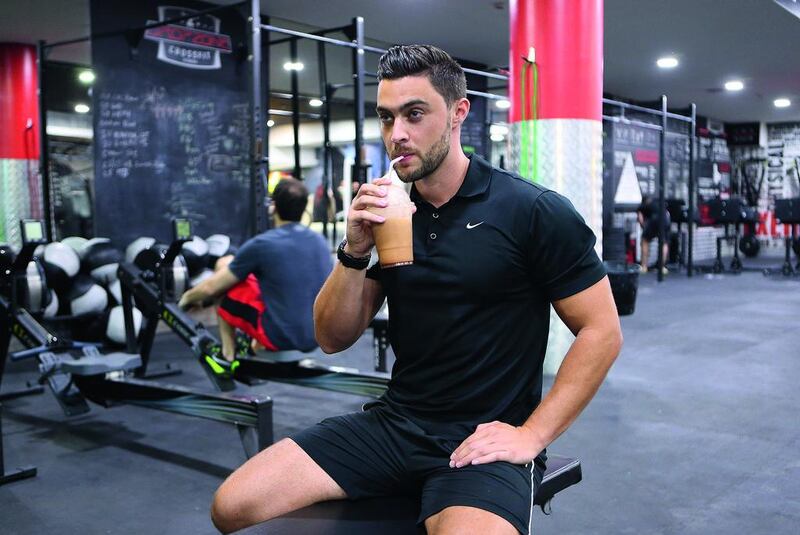With its muscle-building and repairing properties, protein is vital to every diet. When taken in a more concentrated form, such as in a protein shake, within two hours of strenuous exercise, it can help to restore muscle and increase its density and mass.
“In today’s fast-paced society, I think protein shakes have become a necessity, but that does not mean they are always good for you,” says Daniel Woolley, executive director and personal trainer at Target Fitness, Dubai.
“I like to drink one right after my workout, but mine will also include quick-release carbohydrates. When you train hard, you deplete yourself of glycogen, so it helps to get energy back up.
“Whatever your fitness goal is – to lose weight or gain muscle – you will require a certain amount of calories per day to maintain your energy expenditure,” Woolley explains. “If we are struggling to hit these with our normal diet, due to lack of cooking time or time to eat, then a protein shake can be a good option. Anyone who lifts weights or exercises hard will benefit, and if you choose a good protein shake, which includes vitamins and amino acids, it can help you to recover and repair muscle more quickly.”
While shakes can be quick and convenient, Stephanie Karl, clinical nutritionist at JTS Medical Centre in Dubai, says it is better to start by eating clean protein-rich food as part of a normal diet. An average scoop of powder can deliver around 20 grams of pure protein – the same as a small palm-sized portion of lean chicken, fish or meat.
“A protein shake can help fill gaps for those who are more serious about their protein intake and how quickly it is absorbed into their body, so that is why they are a good option if you are working out at a high intensity,” says Karl.
“Women should typically take around 1 to 1.5g protein per kilogram of their body weight, and up to 1.7g if they are doing a lot of resistance exercise,” she advises. “Men can take 1.7g of pure protein per kilo if they are doing heavy weightlifting, and research indicates that up to 2.2g per kilo of body weight builds more muscle.”
Protein powder is made by isolating the protein part of food from the fats and carbohydrates, while hydrolysing can select specific amino acids to keep in the powder. One of the most common types is whey protein, which is made from curdling and straining milk. It is absorbed quickly by the body and also contains essential amino acids. Casein protein is another common form, also derived from milk, which is more slowly released. If you are dairy, lactose or gluten-intolerant, vegetarian or vegan, there are plant-based options on the market, made from soy, flax, rice, pea or chia proteins.
While soy is often the mainstay of a vegetarian diet and has a complete range of amino acids, explains Karl, soy protein-based powders are not suitable for everyone. “It is not great for men, or women who have a family history of breast cancer, due to the naturally intrinsic isoflavones and their interaction with our hormones. Soy can reduce testosterone in men and increase oestrogen in women, and the protein concentrate is also not so well absorbed. Rice protein powder is a good option although it is low in lysine, a very important amino acid for muscle-building. It works better when blended with an animal protein or other plant proteins.”
So how do you choose the best one, with so many available on the market? The rule of thumb, says Woolley, is that the longer the list of ingredients, the more likely it is to include unhealthy artificial additives. “I avoid anything containing soy protein and artificial ingredients, sweeteners, fillers, vegetable oils and fats, gluten or anything hydrogenated,” he says.
“Avoid chemical sweeteners and shakes with claims of extra performance,” agrees Karl. “There should always be a label asserting processing to industry standards.” Aspartame, acesulfame and sucralose are three examples of artificial sweeteners that you might encounter in some protein powders, and while they may make your shake taste more palatable, these should be avoided.
Moderation is also crucial, says Karl, who says high doses of concentrated protein taken repeatedly can result in side effects. “I often see men with acne on their face and back, from whey protein that was recommended by a trainer or friend. It is always better to trial a small container rather than a large one to check for any adverse reactions.”
Bloating and digestive issues can be common, while too much concentrated protein can cause urea [the nitrogenous breakdown product of protein metabolism] in the gut and irritable bowels. “L-arginine, an amino acid found in protein foods, helps clear urea, but taking a break from protein powders every three months is recommended, as it can place a big burden on the kidneys,” says Karl. Protein in excess will also break down to glucose in the liver and then turn to fat if the body does not require it, so think first about your workout’s intensity and if it really requires the extra boost of protein that a shake can help to deliver.
Recipe: Vegan ‘Protein Dream’ smoothie
Serves 1
Ingredients
1 medium banana, preferably frozen, sliced
3/4 cup almond milk (good quality, unsweetened)
2 tbsp smooth unsweetened peanut or almond butter
1 tbsp chia seeds
1 tsp maple syrup
1/2 tsp cinnamon
Pinch of Himalayan sea salt
* Option to add 1 scoop of SunWarrior classic vegan protein powder
Method
Place all the ingredients in a blender, along with a few ice cubes if preferred, and blend until smooth.
* Contains approximately 10.5g of protein per serving (without the added protein powder).
Recipe courtesy Laura Holland, www.BeUCleanse.com






